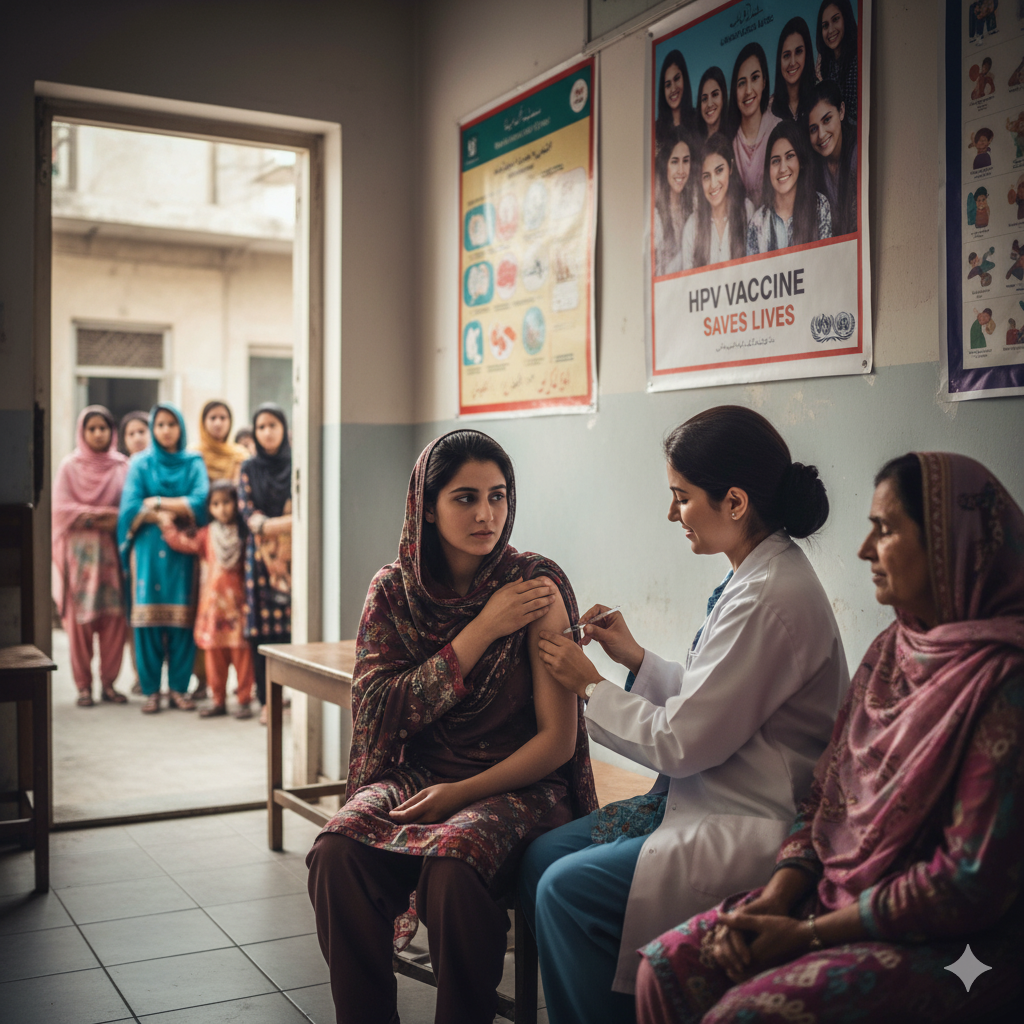Introduction: When Myths Become Deadly
In 1991, while studying in London, I noticed how cultural stigmas prevented many young Pakistani-origin women from accessing a simple, life-saving screening test — the Pap smear. Decades later, similar attitudes continue to put women’s health at risk in Pakistan. This time, the target of suspicion is the HPV vaccine, a breakthrough intervention proven to prevent cervical cancer.
Globally, the HPV vaccine is celebrated as a medical triumph. Yet in Pakistan, misinformation and vaccine hesitancy are slowing its progress. This raises urgent questions: Why is resistance so strong? What is at stake? And how can Pakistan overcome the myths to protect its women and future generations?
Cervical Cancer: A Silent Epidemic in Pakistan
Cervical cancer is the fourth most common cancer in women worldwide, but in Pakistan, the statistics are alarming:
- Every year, 5,000–5,200 Pakistani women are diagnosed with cervical cancer.
- Around 3,200 women die annually — that’s nearly 9 women every day.
- According to the International Agency for Research on Cancer (IARC), cervical cancer accounts for 6.9% of all female cancers in Pakistan.
The tragedy lies in the fact that most cases are preventable. More than 70% of cervical cancers are caused by persistent infection with high-risk human papillomavirus (HPV). With timely vaccination and regular screening, the burden could be dramatically reduced.
The HPV Vaccine: A Proven Life-Saver
Introduced in 2006, the HPV vaccine has transformed women’s health in countries where it was widely adopted:
- Australia is on track to eliminate cervical cancer by 2035 after nationwide vaccination.
- In the UK, cervical cancer rates among women under 25 dropped by 87% after routine HPV vaccination.
- A 2020 Lancet study covering 60 million people across 14 countries found the vaccine cut HPV infections by 83% in teen girls and 66% in women aged 20–24.
Pakistan officially launched its HPV vaccination campaign in 2025, supported by the World Health Organization, UNICEF, and Gavi, the Vaccine Alliance. The target: vaccinate 13 million girls aged 9–14 across the country.
Vaccine Hesitancy: Myths and Misconceptions
Despite overwhelming scientific evidence, the rollout has faced backlash. Resistance isn’t only from religious hardliners — it is increasingly fueled by educated but misinformed voices.
Common Myths in Pakistan
- “The HPV vaccine promotes vulgarity.”
- “It has hidden side effects.”
- “It’s a Western conspiracy to reduce Muslim populations.”
These myths echo global anti-vaccine narratives but are particularly dangerous in Pakistan’s fragile healthcare environment. Even a single viral post can deter thousands of parents from allowing their daughters to be vaccinated.
Lessons from Polio: A Warning Sign
Pakistan’s struggles with polio vaccination provide a painful reminder of the consequences of vaccine mistrust:
- Since 2012, at least 109 polio workers have been killed in Khyber Pakhtunkhwa alone.
- The CIA’s use of a fake hepatitis vaccination campaign in 2011 to locate Osama bin Laden deeply eroded trust, causing long-term damage to public health efforts.
- As of 2024, Pakistan remains one of only two countries in the world (along with Afghanistan) where polio is still endemic.
The HPV campaign risks suffering a similar fate if myths and conspiracy theories are not countered effectively.
The Cost of Inaction
Failing to vaccinate against HPV is not just a health risk — it is an economic burden.
- Treatment costs: Managing cervical cancer can cost PKR 1–2 million per patient, often bankrupting families.
- Productivity loss: A World Bank estimate shows that women’s cancers cost developing economies billions annually in lost productivity.
- Preventive savings: The HPV vaccine, by contrast, costs only a fraction and provides protection for decades.
Simply put: prevention is far cheaper, more sustainable, and more humane than treatment.
Global Comparisons: Where Pakistan Stands
While over 140 countries have included HPV vaccination in their national immunization schedules, coverage varies:
- Rwanda became the first African country to introduce HPV vaccination nationwide and achieved more than 90% coverage.
- Bangladesh began HPV vaccination in 2016 and has steadily expanded coverage.
- India, Pakistan’s neighbor, launched its national HPV vaccination program in 2023, aiming to vaccinate 68 million adolescent girls.
Pakistan is already lagging, and widespread hesitancy could worsen the gap.
Combating Misinformation: The Way Forward
To ensure success, Pakistan must combine medical science with cultural sensitivity and innovative communication.
Recommended Strategies
- Celebrity advocacy: Figures like Shehzad Roy, Mahira Khan, and other trusted personalities must publicly endorse the vaccine.
- Religious endorsement: Scholars from mainstream Islamic councils should clarify that the vaccine is a preventive health measure, not a moral issue.
- Digital counter-campaigns: Since misinformation spreads rapidly on TikTok, Instagram, and YouTube, the government must invest in digital awareness campaigns.
- School-based vaccination: Ensuring vaccines are available in schools will boost access while normalizing preventive care.
- Community mobilization: Lady health workers, who have built trust at the grassroots level, should be central to the rollout.
Women’s Health as a National Priority
Pakistan cannot advance socially or economically while neglecting women’s health. Protecting women from preventable diseases like cervical cancer is not charity — it is nation-building.
Empowered, healthy women strengthen families, contribute to the workforce, and ensure generational progress. As Shehzad Roy emphasizes, women’s empowerment is a public health emergency.
FAQs on HPV Vaccine in Pakistan
Q1: Is the HPV vaccine safe?
Yes. WHO, CDC, and over 140 governments confirm it is safe and effective. Adverse reactions are rare and mild (fever, soreness).
Q2: At what age should girls receive the HPV vaccine?
The vaccine is most effective between ages 9–14, before exposure to HPV.
Q3: Can boys also benefit?
Yes. Many countries vaccinate boys to reduce HPV transmission and protect against throat, anal, and penile cancers.
Q4: How many doses are required?
Typically two doses for girls under 15, and three doses for those older.
Q5: What is Pakistan’s coverage target?
The goal is to vaccinate 13 million girls nationwide by 2027.
Conclusion: Fighting for Women’s Lives
The HPV vaccine offers Pakistan a rare opportunity: the chance to prevent thousands of unnecessary deaths each year. But this opportunity will be lost if misinformation and cultural stigma are allowed to dominate.
Vaccination is not a Western plot, nor a political tool. It is a shield — one that protects mothers, daughters, and future generations from needless suffering. For Pakistan, the real question is not whether we can afford the vaccine. It is whether we can afford the cost of inaction.







